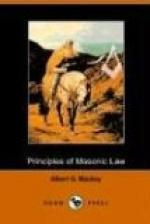In the absence of any written law upon the subject, we are compelled to look to precedent for authority; and, although the Grand Lodges in the United States have seldom been established with a representation of less than four lodges, the fact that that of Texas was organized in 1837 by the representatives of only three lodges, and that the Grand Lodge thus instituted was at once recognized as legal and regular by all its sister Grand Lodges, seems to settle the question that three subordinates are sufficient to institute a Grand Lodge.
Three lodges, therefore, in any territory where a Grand Lodge does not already exist, may unite in convention and organize a Grand Lodge. It will then be necessary, that these lodges should surrender the warrants under which they had been previously working, and take out new warrants from the Grand Lodge which they have constituted; and, from that time forth, all masonic authority is vested in the Grand Lodge thus formed.
The Grand Lodge having been thus constituted, the next inquiries that suggest themselves are as to its members and its officers, each of which questions will occupy a distinct discussion.
Chapter III.
Of the Members of a Grand Lodge.
It is an indisputable fact that the “General Assembly” which met at York in 926 was composed of all the members of the fraternity who chose to repair to it; and it is equally certain that, at the first Grand Lodge, held in 1717, after the revival of Masonry, all the craft who were present exercised the right of membership in voting for Grand Officers,[7] and must, therefore, have been considered members of the Grand Lodge. The right does not, however, appear to have been afterwards claimed. At this very assembly, the Grand Master who had been elected, summoned only the Master and Wardens of the lodges to meet him in the quarterly communications; and Preston distinctly states, that soon after, the Brethren of the four old lodges, which had constituted the Grand Lodge, considered their attendance on the future communications of the society unnecessary, and therefore concurred with the lodges which had been subsequently warranted in delegating the power of representation to their Masters and Wardens, “resting satisfied that no measure of importance would be adopted without their approbation.”
Any doubts upon the subject were, however, soon put at rest by the enactment of a positive law. In 1721, thirty-nine articles for the future government of the craft were approved and confirmed, the twelfth of which was in the following words:




